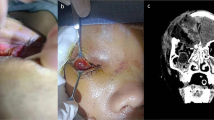Abstract
We report four typical cases of a strangulated trapdoor type, blow-out fracture of the orbital floor in children under the age of 10 years. Diplopia and restricted eye movement were observed soon after the accident, and surgical interventions were performed approximately within 2 weeks from the impact in all four cases. Close intraoperative observations revealed all the fractures to be trapdoor-like, with the “hinge” located medially and the “door” bounded by a bony defect of a few millimetres wide along the infraorbital groove and two fracture lines in a coronal direction running from the groove, perpendicularly and medially. Furthermore, we found strangulation of soft tissue in the fracture line along the infraorbital groove. We believe that this type of fracture occurs due to the premature development of the orbit in children. All children were surgically treated with release of the trapped orbital tissue, but recovery of ocular movement required 2 to 3 months. Consensus has it that early operation is favourable for this type of fracture. However our cases show that favourable results can be attained by operation done even after 2 weeks. Understanding of the bony structure and the fracture pattern of the orbit in children will help in the accurate imaging diagnosis and selection of operative procedures.





Similar content being viewed by others
References
Anderson PJ, Poole MD (1995) Orbital floor fracture in young children. J Craniomaxillofac Surg 23:151–154
Bansagi ZC, Meyer DR (2000) Internal orbital fractures in the pediatric age group: characterization and management. Ophthalmology 107:829–836
Brady AM, McMann MA, Mazzola RA, Bushley DM, Ainbinder DJ, Carroll RB (2001) The diagnosis and management of orbital blow-out fractures: update 2001. Am J Emerg Med 19:147–154
Cope MR, Moos KF, Speculand B (1999) Does diplopia persist after blow-out fracture of the orbital floor in children. Br J Oral Maxillofac Surg 37:6–51
Egbert JE, May K, Kersten RC, Kulwin DR (2000) Pediatric orbital floor fracture: direct extraocular muscle involvement. Ophthalmology 107:1875–1879
Grant JH, Patrinely, JR, Weiss AH, Kierney PC, Gruss JS (2002) Trapdoor fracture of the orbit in a pediatric population. Plast Reconstr Surg 109:482–489
Harley RD (1975) Surgical management of persistent diplopia in blow-out fractures of the orbit. Ann Ophthalmol 7:1621–1626
Jordan DR, Allen LH, White J, Harvey J, Esmaeli B (1998) Intervention within days for some orbital floor fractures: the white-eyed blow-out. Ophthal Plast Reconstr Surg 14:379–390
Koltai PJ, Amjad I, Meyer DR, Feustel PJ (1995) Orbital fractures in children. Arch Otolaryngol Head Neck Surg 121:1375–1379
Kushner BJ (1982) Paresis and restriction of the inferior rectus muscle after orbital floor fracture. Am J Ophthalmol 94:81–86
Leitch RJ, Burke JP, Strachan IM (1990) Orbital blow-out fractures, the influence of age on surgical outcome. Acta Ophthalmol 68:118–124
De Man K, Wijngaarde R, Hes J, de Jong PT (1991) Influence of age on the management of blow-out fractures of the orbital floor. Int J Oral Maxillofac Surg 20:330–336
Mizuno A, Nakamura T, Kawabata T, Shigeno T, Motegi K, Watanabe I (1985) Blow-out fracture of the orbit in 4 children. Int J Oral Surg 14:284–289
Sires BS (1999) Orbital trapdoor fracture and oculocardiac reflex. Ophthal Plast Reconstr Surg 15:301–302
Sires BS, Stanley RB, Levine LM (1998) Oculocardiac reflex caused by orbital floor trapdoor fracture: an indication for urgent repair. Arch Ophthalmol 116:955–956
Soll DB, Poley BJ (1965) Trapdoor variety of blow-out fracture of the orbital floor. Am J Ophthalmol 60:269–272
Soll SM (2000) Trapdoor orbital fractures. Ophthal Plast Reconstr Surg 16:306–307
Wachler BS, Holds JB (1998) The missing muscle syndrome in blow-out fractures: an indication for urgent surgery. Ophthal Plast Reconstr Surg 14:17–18
Yanagi Y (1989) Studies on the development and growth of the human maxilla - special references to the anterolateral, infra-temporal and orbital surfaces. Hokkaido Igaku Zasshi 64(5):648–666
Author information
Authors and Affiliations
Corresponding author
Rights and permissions
About this article
Cite this article
Ogata, H., Kaneko, T., Nakajima, T. et al. Strangulated trapdoor type orbital blow-out fractures in children. Fracture pattern and clinical outcome. Eur J Plast Surg 27, 12–19 (2004). https://doi.org/10.1007/s00238-004-0612-3
Received:
Accepted:
Published:
Issue Date:
DOI: https://doi.org/10.1007/s00238-004-0612-3




